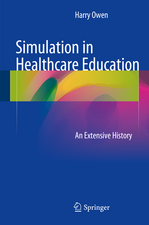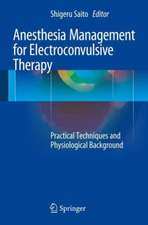Comprehensive Healthcare Simulation: Anesthesiology: Comprehensive Healthcare Simulation
Editat de Bryan Mahoney, Rebecca D. Minehart, May C. M. Pian-Smithen Limba Engleză Paperback – 19 dec 2019
The Comprehensive Textbook of Healthcare Simulation: Anesthesiology is written and edited by leaders in the field and includes hundreds of high-quality color surgical illustrations and photographs.
Din seria Comprehensive Healthcare Simulation
- 5%
 Preț: 729.98 lei
Preț: 729.98 lei - 5%
 Preț: 878.08 lei
Preț: 878.08 lei - 5%
 Preț: 673.91 lei
Preț: 673.91 lei - 5%
 Preț: 921.05 lei
Preț: 921.05 lei - 5%
 Preț: 941.16 lei
Preț: 941.16 lei - 5%
 Preț: 572.99 lei
Preț: 572.99 lei - 5%
 Preț: 1025.66 lei
Preț: 1025.66 lei - 5%
 Preț: 505.24 lei
Preț: 505.24 lei - 5%
 Preț: 713.40 lei
Preț: 713.40 lei - 5%
 Preț: 849.45 lei
Preț: 849.45 lei - 5%
 Preț: 678.68 lei
Preț: 678.68 lei - 19%
 Preț: 384.72 lei
Preț: 384.72 lei - 5%
 Preț: 794.80 lei
Preț: 794.80 lei - 5%
 Preț: 791.42 lei
Preț: 791.42 lei - 5%
 Preț: 852.77 lei
Preț: 852.77 lei - 5%
 Preț: 801.42 lei
Preț: 801.42 lei -
 Preț: 457.80 lei
Preț: 457.80 lei
Preț: 766.78 lei
Preț vechi: 807.15 lei
-5% Nou
Puncte Express: 1150
Preț estimativ în valută:
146.72€ • 153.74$ • 121.29£
146.72€ • 153.74$ • 121.29£
Carte tipărită la comandă
Livrare economică 08-14 aprilie
Preluare comenzi: 021 569.72.76
Specificații
ISBN-13: 9783030268480
ISBN-10: 3030268489
Pagini: 348
Ilustrații: XVI, 348 p. 79 illus., 72 illus. in color.
Dimensiuni: 210 x 279 mm
Greutate: 1.18 kg
Ediția:1st ed. 2020
Editura: Springer International Publishing
Colecția Springer
Seria Comprehensive Healthcare Simulation
Locul publicării:Cham, Switzerland
ISBN-10: 3030268489
Pagini: 348
Ilustrații: XVI, 348 p. 79 illus., 72 illus. in color.
Dimensiuni: 210 x 279 mm
Greutate: 1.18 kg
Ediția:1st ed. 2020
Editura: Springer International Publishing
Colecția Springer
Seria Comprehensive Healthcare Simulation
Locul publicării:Cham, Switzerland
Cuprins
Part I. Introduction to Simulation for Anesthesiology.- Ch 1: Anesthesia and Simulation: A Historic Relationship.- Ch 2: Education and Learning Theory.- Ch 3: Essentials of Scenario Building.- Ch 4: Essentials of Debriefing in Simulation-based Education.- Ch 5: Crisis Resource Management and Interdisciplinary Team Training.- Ch 6: Competency Assessment.- Ch 7: Role of Simulation in Healthcare Quality Assurance.- Ch 8: Licensure and Certification.- Ch 9: Leadership and Endorsement.- Part II. Simulation Modalities and Technologies.- Ch 10: Standardized Patients.- Ch 11: Mannequin-based Simulators and Part-Task Trainers.- Ch 12: Computer and Web-based Simulators, Virtual Environments.- Part III. General Practice of Anesthesiology.- Ch 13: Undergraduate Medical Education.- Ch 14: Graduate Medical Education.- Ch 15: Faculty and Allied Health Providers.- Part IV. Subspecialties of Anesthesiology.- Ch 16: Simulation in Pediatrics.- Ch 17: Simulation in Cardiothoracic and Vascular Anesthesia.- Ch 18: Simulation in Obstetrics.- Ch 19: Simulation in Immersive Learning Techniques: Interdisciplinary Pain Medicine.- Ch 20: Simulation in Critical Care Medicine.- Ch 21: Simulation in Regional Anesthesia.- Ch 22: Simulation in Orthotopic Liver Transplantation.- Ch 23: Simulation in Trauma/Advanced Cardiac Life Support.- Ch 24: Simulation in Otolaryngology and Airway.- Ch 25: Simulation in Neuroanesthsia.- Ch 26: Simulation in Perioperative Medicine: From Preoperative Clinics to Postoperative Wards.- Ch 27: Simulation in Low Resource Settings: A Review of the Current State and Practical Implementation Strategies.- Part V. Conclusion.- Ch 28: A Translational Roadmap to Create the Future of Simulation in Healthcare.
Notă biografică
Bryan Mahoney, MD
Assistant Professor, Residency Program Director
Mount Sinai St Luke’s and West Hospitals
Department of Anesthesiology
1000 10th Ave N.
New York, NY 10029
USA
Rebecca D. Minehart, MD, MSHPEd
Assistant Professor of Anaesthesia, Harvard Medical School
Massachusetts General Hospital
Department of Anesthesia, Critical Care and Pain Medicine
55 Fruit Street
GRB 440
Boston, MA 02114
USA
May C. M. Pian-Smith, MD, MS
Associate Professor of Anesthesia, Harvard Medical School
Massachusetts General Hospital
Department of Anesthesia, Critical Care and Pain Medicine
55 Fruit Street
GRB 440
Boston, MA 02114
USA
Textul de pe ultima copertă
This book functions as a practical guide for the use of simulation in anesthesiology. Divided into five parts, it begins with the history of simulation in anesthesiology, its relevant pedagogical principles, and the modes of its employment. Readers are then provided with a comprehensive review of simulation technologies as employed in anesthesiology and are guided on the use of simulation for a variety of learners: undergraduate and graduate medical trainees, practicing anesthesiologists, and allied health providers. Subsequent chapters provide a ‘how-to” guide for the employment of simulation across wide range of anesthesiology subspecialties before concluding with a proposed roadmap for the future of translational simulation in healthcare.
The Comprehensive Textbook of Healthcare Simulation: Anesthesiology is written and edited by leaders in the field and includes hundreds of high-quality color surgical illustrations and photographs.
The Comprehensive Textbook of Healthcare Simulation: Anesthesiology is written and edited by leaders in the field and includes hundreds of high-quality color surgical illustrations and photographs.
Caracteristici
Provides an introduction to simulation for anesthesiology Functions as a guide to simulation education with all levels of learners Gives a comprehensive review of all modalities of simulation utilization, and a "how to" approach to curriculum development across all subspecialities of anesthesiology practice Chapters cover introduction to simulation for anesthesiology, general practice of anesthesiology, and subspecialities such as pediatrics, obstetrics, pain medicine, critical care, neuro, trauma, and ambulatory and office-based anesthesiology






















